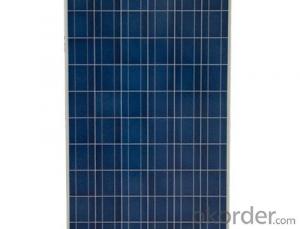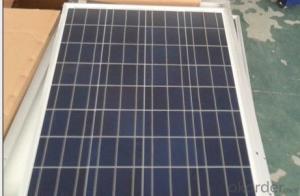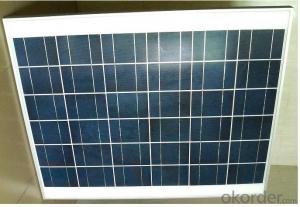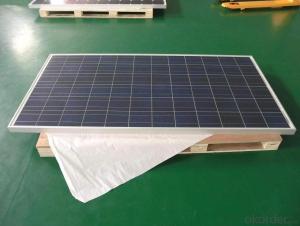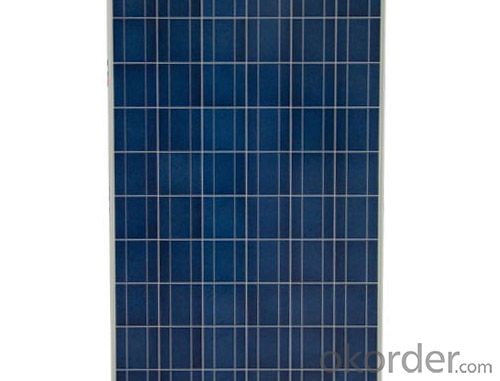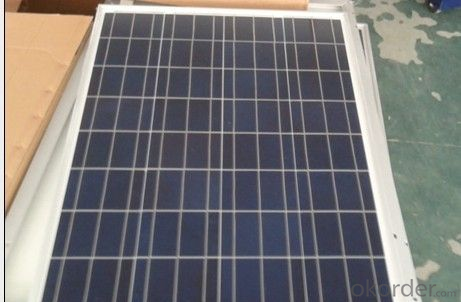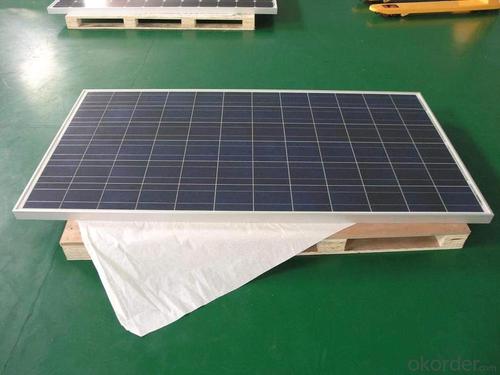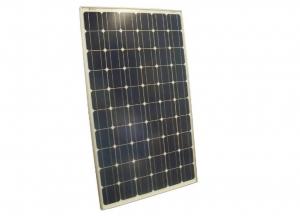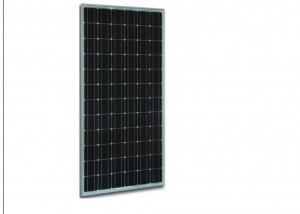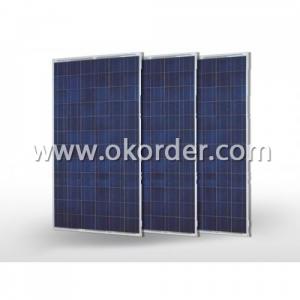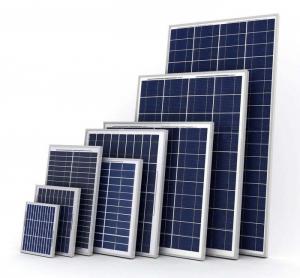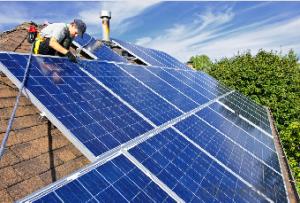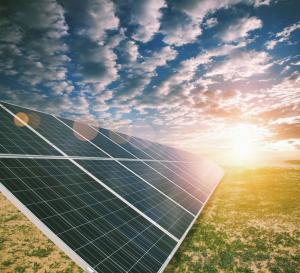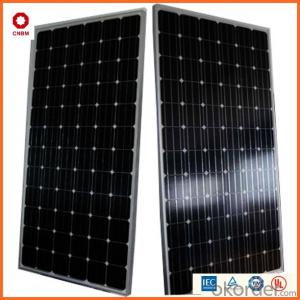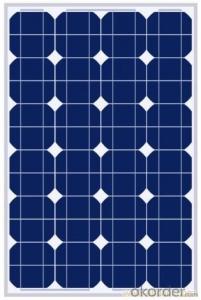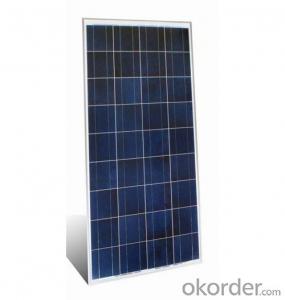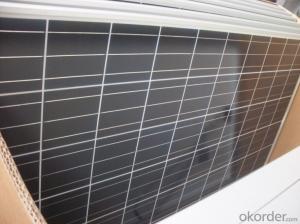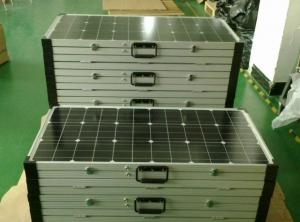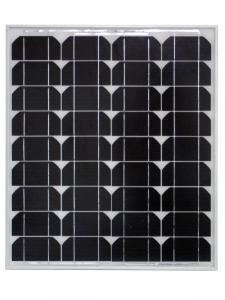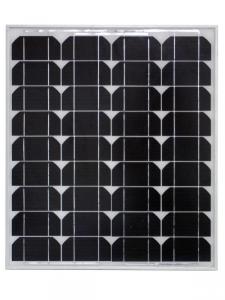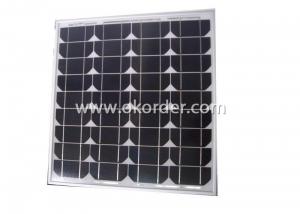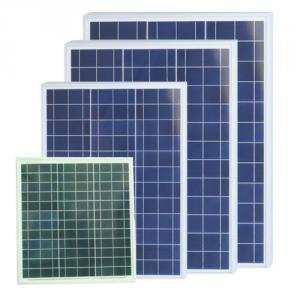Solar Panels on A Slate Roof - Crystalline Solar Panels Made in China/India
- Loading Port:
- Shanghai
- Payment Terms:
- TT OR LC
- Min Order Qty:
- 78000 watt
- Supply Capability:
- 10000000 watt/month
OKorder Service Pledge
OKorder Financial Service
You Might Also Like
Poly-Crystalline solar panel, Poly 156 cell, 60pcs.Power range 230W-260W.
Solar panel refers either to a photovoltaic (PV) module, a solar hot water panel, or to a set of solar photovoltaic modules electrically connected and mounted on a supporting structure. A PV module is a packaged, connected assembly of solar cells. Solar panels can be used as a component of a larger photovoltaic system to generate and supply electricity in commercial and residential applications. Each module is rated by its DC output power under standard test conditions, and typically ranges from 100 to 320 watts. The efficiency of a module determines the area of a module given the same rated output – an 8% efficient 230 watt module will have twice the area of a 16% efficient 230 watt module. There are a few solar panels available that are exceeding 19% efficiency. A single solar module can produce only a limited amount of power; most installations contain multiple modules. A photovoltaic system typically includes a panel or an array of solar modules, an inverter, and sometimes a battery and/or solar tracker and interconnection wiring.
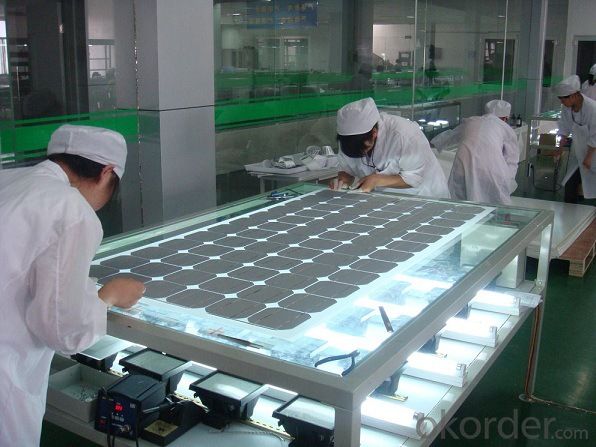
Quality and Safety
1. Rigorous quality control meets the highest international standards.
2. High-transmissivity low-iron tempered glass, strong aluminium frame.
3. Using UV-resistant silicon.
4. IS09001/14001/CE/TUV/UL
Warranties
1. 10 years limited product warranty
2. 15 years at 90% of the minimal rated power output
3. 25 years at 80% of the minimal rated power output
Technical date :
ITEM NO.: | Poly 156*156 cell ,60pcs . Power range from 230Wp-260Wp | ||||||
Maximum Power(W) | 230 | 235 | 240 | 245 | 250 | 255 | 260 |
Optimum Power Voltage(Vmp) | 29.4 | 29.5 | 29.7 | 30.1 | 30.3 | 30.5 | 30.7 |
Optimum Operatige Current(Imp) | 7.83 | 7.97 | 8.08 | 8.14 | 8.25 | 8.37 | 8.48 |
Open Circuit Voltage(Voc) | 36.7 | 36.8 | 36.9 | 37.1 | 37.3 | 37.5 | 37.7 |
Short Circuit Current(Isc) | 8.52 | 8.59 | 8.62 | 8.65 | 8.69 | 8.73 | 8.78 |
Solar Cell: | 156*156 Poly | ||||||
Number of Cell(pcs) | 6*10 | ||||||
Brand Name of Solar Cells | JA Cell, Bluesun Cell | ||||||
Size of Module(mm) | 1650*992*40/45/50 | ||||||
Cable & Connector Type | Pass the TUV Certificate | ||||||
Frame(Material Corners,etc.) | Aluminium-alloy | ||||||
Back sheet | TPT | ||||||
Weight Per Piece(KG) | 19.5KG | ||||||
FF (%) | 70-76% | ||||||
Junction Box Type | Pass the TUV Certificate | ||||||
Tolerance Wattage(e.g.+/-5%) | ±3%, or 0-3% | ||||||
Front Glass Thickness(mm) | 3.2 | ||||||
Temperature Coefficients of Isc(%) | +0.04 | ||||||
Temperature Coefficients of Voc(%) | -0.38 | ||||||
Temperature Coefficients of Pm(%) | -0.47 | ||||||
Temperature Coefficients of Im(%) | +0.04 | ||||||
Temperature Coefficients of Vm(%) | -0.38 | ||||||
Temperature Range | -40°C to +85°C | ||||||
Surface Maximum Load Capacity | 5400Pa | ||||||
Allowable Hail Load | 23m/s ,7.53g | ||||||
Bypass Diode Rating(A) | 12 | ||||||
Warranty | 90% of 10 years, 80% of 25 years. | ||||||
Standard Test Conditions | AM1.5 1000W/ 25 +/-2°C | ||||||
Packing | carton or pallet | ||||||
1*20' | 14 Pallets / 316pcs | ||||||
1*40'STD | 25 Pallets / 700pcs | ||||||
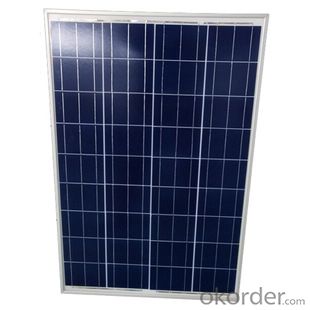
FAQ
I..Will you focus on the safety of the goods during transportation?
Yes, Safety of the cargo is the primary element that we would consider on transportation.
II..How would guarantee the quality will meet the requirements of your clients?
Before shipment, we will have inspection for each batch of goods.
III..What certificates do you have?
IEC,UL,TUV,CSA,etc.
IV..Can you do OEM according to clients’ requirements?
Yes, we have our own brand while we can provide OEM service.
- Q: Can solar panels be installed on windows?
- Yes, solar panels can be installed on windows. There are specially designed solar window panels available that can be installed on the glass surface of windows to harness solar energy. These panels are transparent and allow light to pass through while generating electricity from the sunlight.
- Q: Do solar panels require maintenance?
- Yes, solar panels do require maintenance. Regular cleaning to remove dirt, dust, and debris is necessary to ensure optimal efficiency. Additionally, periodic inspections and maintenance checks are recommended to identify and address any potential issues such as loose connections, wiring problems, or shading that may affect performance. However, compared to other forms of energy generation, solar panels require relatively low maintenance efforts.
- Q: I really would like to have my own solar panel, but i don't know how. Most of the panels i have looked at are for car batteries but i'm not sure how this would be able to be transfered into electricity. I'm looking to power things like lamps, a stereo and various chargers for phones and ipods. Please explain to me how i could adapt a solar panel to my uses. Thank you.
- Yes, it can. Now what do you expect out of it? It can reduce your electric bill by some amount. That amount depends on how many solar panels you install and how sunny your days are. You have to pretty much cover a roof to get a substantial electric reduction. There are 2 companies where I live that have installed solar panels and covered most of their roofs with them. They've reduced their electric bill by about 30%. It's expensive to do this. Don't expect a fast pay back. In fact you may save more by using solar heating panels for hot water than by using solar electric panels. I think it's cheaper as well.
- Q: can solar power panels installed at home provide enough electricity to power house hold appliainces and heat water.
- Yes, but people usually balk at the cost. Right now, the photoelectric materials are rather expensive. So, most people figure it is not worth spending thousands of dollars and will gladly pay hundreds of dollars a month to the electric company. Most estimates are that it takes at least a year and a half to two years to recover the cost of the panels by how much one can save on their electric bill. Most persons would rather pay out that money in little increments to the electric company instead of all at once when having their home built. Just a side note of trivia: The ability of certain materials to turn photons of light into electric current or the photoelectric effect is what Einstein was awarded his Nobel Prize for, not Relativity.
- Q: How do solar panels affect the property's energy efficiency rating?
- Solar panels have a positive impact on a property's energy efficiency rating by generating clean, renewable energy. By harnessing sunlight and converting it into electricity, solar panels reduce the reliance on traditional energy sources, leading to lower energy consumption and costs. This increased energy efficiency contributes to a higher rating for the property.
- Q: Got a small project here in a remote location. There is to be a 2 volt deep cycle battery, the equipment to be powered from battery and solar panel to charge battery. The 2 volt battery puts out 55 AH. the max constant power draw from the equipment to be powered is 7.9 watts. Will a 30 watt panel at 2 volts be enough to run this system during sunlight and charge the battery for the equipment to run overnight?And, at 55 AH, how long can I keep a constant draw of 7.9 watts without a recharge?Thanks to all the input!
- Will a 30 watt panel at 2 volts be enough to run this system during sunlight and charge the battery for the equipment to run overnight? Maybe theoretically, but you're going to have very little margin for losses and clouds. I'll bet it has very little power when cloudy. 7.9/30 = 0.26. So at 00% efficiency, you'd need it to be charging more than 25% of each 24 hour period. In a summer with long days and a climate with few clouds, you might make it. But I think you're very close to the edge. And, at 55 AH, how long can I keep a constant draw of 7.9 watts without a recharge? For an ideal battery: time = Q V / P time = 55 A h * 2V / 7.9W time = 83 hours So you've got pretty good margin on your battery.
- Q: I need a list of worldwide solar panel manufactures from china, US, Spain, Germany, Japan etc...Can any one direct ne to such place?I rather it will also contain comparison of parameters like efficiacy, quality etc and to be divedied by country of manufacturing.Thank you
- Actually Ofir, it is much easier and less expensive than you might believe. What you need is a magazine, like, Solar Today. There is only one that I am familiar with that gets into the nuts and bolts of solar panel manufacturers, installation, and other types of renewable energy. It's called, Home Power Magazine. We have a home that has been powered by the wind and sun for the last 0 years or so, and most of our initial information came from Home Power, and afterward, from many of the sources that they have in their articles. Every few issures, they take an item connected to renewable energy, such as an inverter, wind turbine, water turbine, or solar panel, and list all the different models that are available. They are broken down by manufacturer, and include specifications like power output, range of voltages, efficiency, materials, and even where they are manufactured. If you subscribe online for one year, the cost is around $25 USD, you will have access to all the previous issues that are archived on their website. You can use their search engine to locate an article listing all the solar panels, they did one a year or so ago with all the information you are looking for. Despite what you might be hearing, solar power usage is growing at an incredible rate. In the US alone, there are over 00,000 homes and businesses operating some level of solar power right now, that's good news. As far as different countries using different requirements, most all of the manufacturers today are selling their products to most countries worldwide, they are designed to meet requirements for almost anyplace you might use them. Check the magazine out today, you might learn more than you were originally looking for. I will include their link below, and some other good sources for information. You can google any one of them to find their website. Good luck, and take care...Rudydoo
- Q: Can solar panels be used to power a waste management facility?
- Yes, solar panels can be used to power a waste management facility. Solar energy can be harnessed to generate electricity which can be utilized to power the operations of a waste management facility, reducing reliance on traditional energy sources and promoting sustainability.
- Q: I can't figure out how to charge a Ni Cd (BD 8V Firestorm) battery directly with a solar panel so I've come up with an alternative which might or might not work. I thought I would connect an inverter (I found a nice 400W for $30) to my trucks battery and plug the BD Firestorm battery charger into the inverter. Then I was thinking I could use a 5W solar panel to trickle charge the truck battery and keep it connected after the Ni Cd is charged to ensure the truck battery is topped off. The truck would not be running during this process. Will this solution work? Is there a better solution?
- Two of those solar panels connected in series will easily charge a 8V battery. I would not even be concerned about over voltage the solar cells will have plenty of internal resistance.
- Q: I have an off-grid 24volt existing system using 8 x 80 watt 2volt, wired at 24volts, mono solar panels with deep cycle batteries,operating now. I have been given a 240 2volt polly cryst. panel. Can I add this panel to existing panels as above. Thank you, dumb solar man
- Assuming that you have / will upgrade wiring sizes to carry the extra wattage, that the new total wattage resulting from the addition doesn't overload any existing charge controller, diodes and / or inverter you have installed, then paralleling it straight into one of the other 2 volt groups should do nothing but add current to the system. True, it will be somewhat imbalanced, but it will work. Your other options would be to reconfigure everything down to it's native 2 V configuration which will raise current and lower voltage, with the additional panel creating the additional current to raise the wattage or to put it in series with the other 4 panel clusters so that you would get 36 V and additional current to account for the raised wattage. One last approach might be to set it up on another battery bank of it's own (small and at 2 V) to then connect to the same inverter. You'd be getting more power and storage capability that way, sort of a partial backup system, really, that will take some of the load off the other components to help extend their useful lives and get a bit more flexibility into it as well. The choice is yours here. That is all the ways that the system can be connected in, assuming everything in the first sentence checks out;-) It's difficult to make a recommendation without knowing what other components are in use and what the maximum ratings they carry are. Just remember that parallel connections add current and voltage stays the same, series connections add voltage and the current remains the same and you can figure out what to do with this thing to help you if you stay within maximum ratings for the charge controller, diodes and / or inverter involved. Good luck and stay safe!
Send your message to us
Solar Panels on A Slate Roof - Crystalline Solar Panels Made in China/India
- Loading Port:
- Shanghai
- Payment Terms:
- TT OR LC
- Min Order Qty:
- 78000 watt
- Supply Capability:
- 10000000 watt/month
OKorder Service Pledge
OKorder Financial Service
Similar products
Hot products
Hot Searches
Related keywords
